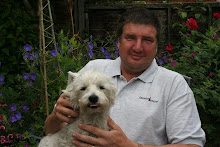 |
| Ivy flowers about to open |
Irish honey bees are different from all other 'tribes' in being adapted to cope with the long, mild, wet winters here. Their dark (mellanistic) bodies give them the name Apis Mellifera (sub-sp Mellifera or AMM for short) make them easy to spot and their special attributes make mockery of the global trends in commercial bee-keeping (Let's buy queens from Italy! Let's use these fantastic "Buckfast" hybrids from Devon!) - Irish beekeepers tend to be looking now, only for genuine dark Irish bees.
 |
| The ivy flowers start to open. |
Worker bees hatching around now are physiologically very different from the short-lived 'Summer' bees; they can live for 6 months and this is not just because they do not have to go out and do all that exhausting foraging for nectar and pollen (and water and propolis). They have fatty 'bodies' under the skin in their abdomen where they can lay down fat to help them through the bad times. The fat comes mainly from ivy pollen, which is good news in Ireland where ivy is hugely abundant (hence, presumably, the co-evolution).
 |
These 'super' frames are in pristine mint condition with none
of the wax 'foundation' drawn up into hexagonal honeycomb
'tubes'. |
 |
Top frame in this pic has drawn comb over all but only
capped-off wax (white crinkly bits) on a small area. The bottom
frame is a bit better. |
Ivy, though, is good for bees, but bad for Irish bee keepers (well, pushy, asset-squeezing, exploitative bee keepers, anyway). The nectar the bees gather from those pollen-rich flowers, when converted to honey by bees and packed into honey comb, sets like concrete! You cannot extract it from the combs in any easy way, so bee keepers make sure that they go through their hives taking off the summer and early autumn honey BEFORE the ivy flowers start to open - about now in these parts. This is the end of the year in honey-harvest terms.
I was pretty sure I'd have no honey to harvest. Regular readers will know that I looked in a while back and saw two completely empty 'super' boxes containing frames of foundation wax like new, as if no bee had ever walked that box and none had started to draw up the hexagonal tubes of honeycomb. I put the lack of honey down to the wet and horrible June and July when the bees would have been unable to go out foraging and would have used up any stores ( gathered in April and May) keeping the larvae alive.
 |
| Dark Irish workers on capped honey. |
One of the hives today was true to this story. The super was still clean and untouched. The bees have probably been 'up' there for an explore but have not needed it yet as a larder. They seem perfectly good and vigorous below this in the "brood and a half" boxes. There are stages to this honey comb. You start by giving the bees your frames of wax sheet embossed with a hexagonal pattern (foundation). The bees add more wax to this, building up the hexagonal tubes of the 'honeycomb' we know. These tubes are then filled with nectar/honey as the stores are dried out and chemically changed (to invert sugars). When the gloop is dry. stiff and changed enough to be honey, the cells are capped off with more wax, crinkly and white this time. Job done.
 |
| Arum berries in the local hedges. |
The style of bee keeping we do in our apiary is very different (I have suggested above) from the intensive, manipulative pushiness of the commercial boys. They are in it to make a living from honey or selling new colonies. I am just trying to sustain colonies on site here to help with pollination (and because I like having them around). If I get honey then that is a bonus. My second hive does, in fact, have some capped (extractable) honey in it but is patchy and light. An Irish hive colony needs around 40-50 lbs honey to see it through the winter. The bees work all summer trying to accumulate this amount FOR THEMSELVES, not so that humans can 'harvest' it. The commercial boys will take honey anyway and if that leaves their hive short they will replace the 'stolen' honey with sugar syrup. I do not do that. I leave them the first 40-50 lbs (about what would be found in the first 'super box') and would only take crop from any 2nd, 3rd or higher boxes. (Some colonies get so strong in a good year, the bee keeper can stack 10 supers up like a hi-rise block)

To cut a long story short, these amounts of honey are not worth extracting and it would do too much damage to the hives to do so, so I have decided to leave them with it this year. Hence, you hopefuls who have been asking whether there would be any honey, I am sorry to disappoint you this year. That's how it goes with 'Natural' beekeeping, I am afraid.
 |
| BIG thistles. |
In other news, we sadly lost one of the tiny Buff Orp chicks this week. We don't know what did for him/her - I spotted that the 2 mums had only 4 chicks with them and went round trying to see if the little mite might be stuck somewhere in need of rescue. I found the body clean and dry, with not a feather out of place, but stretched out on the grass, stiff and lifeless. These things happen. Small Holders have a wry comment to one another to cover this - "Ah well... where there is livestock, there is dead stock". Just not a thriver, I guess.










No comments:
Post a Comment